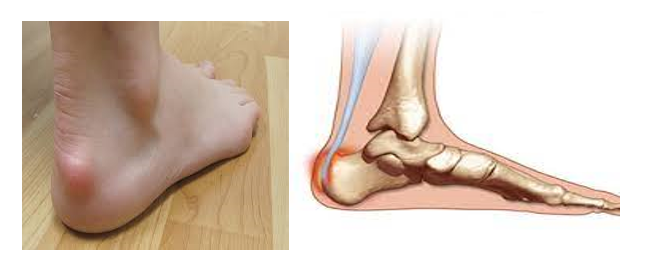
Heel Bump (Haglund’s deformity) which is also known as pump bump or retrocalcaneal exostosis. It is a degenerative process characterized by osteophyte formation and retrocalcaneal bursitis
The anatomical location of the retrocalcaneal bursa is between posterior and superior aspects of the tuberosity of the calcaneus and the anterior aspect of the distal Achilles tendon. It is a common cause of posterior heel pain, characterized clinically by prominent bursal bony projection. Usually, the condition is idiopathic and bilateral but there are some common provoking factors which include age, increased repetitive loading, obesity, and systemic inflammatory disease (psoriatic arthritis, spondyloarthropathy, rheumatoid arthritis, and Reiter’s disease).
It is more prevalent in a young, active population (female > male) including runners and athletes. It usually affects the middle-aged people and females have a higher predisposition than males. Usually, bursal inflammation is due to impingement or mechanical irritation in the dorsiflexion between the Achilles tendon and the calcaneal tuberosity. The clinical features consist of pain at the posterior aspect of the heel which is predominantly present when the patient begins to walk after a period of rest or inactivity.
What are the symptoms of Haglund’s deformity?
Haglund’s deformity can occur in one or both feet. The symptoms may include :-
How is Haglund’s deformity diagnosed?
Xrays with both heel lateral view are basic investigation.
MRI may be needed in advance cases to see soft tissue involvement.
How is Haglund’s deformity treated?
The treatment for Haglund’s deformity usually focuses on relieving pain and taking pressure off of your heel bone.
Nonsurgical options include :
Surgery can be used to treat Haglund’s deformity if less invasive methods don’t work. During surgery, excessive bone will be removed from the heel. The bone may also be smoothed and filed down. This reduces the pressure on the bursa and soft tissue.
This is usually done if your Achilles tendon is damaged
After surgery, it will take up to eight weeks for you to completely heal. You may need to be in boot or cast to protect your foot. You may also need to use crutches for a few days or weeks.
The stitches will have to remain bandaged for at least seven days. Within two weeks, stitches will be removed.

